There are many large, dangerous animals in Alaska. We have seen large dangerous animals frequently on our route here in Alaska. In Denali National Park, we really started seeing how wild Alaska can be. At Denali, we saw numerous Grizzly Bears. Sometimes they were really close to us. Three of the following pictures of mom with her three cubs were taken with a cell phone camera.
Introduction to bears
There are three different types of bears in North America. The Polar Bear, the Brown Bear, and the Black Bear. We haven’t gone far enough north to see any Polar Bears.
Brown Bears and Grizzly bears are both the same species. In Alaska, they call Brown Bears found away from the coast Grizzly Bears. On the coast, they keep their Brown Bear name. On Kodiak Island, they are sometimes called Kodiak Bears. In other areas, they call the Brown Bears, Coastal Brown Bears.

All bears eat anything they can get their lips around (omnivores) this includes insects all the way up to and including whales. Even other bears are on the potential food list. All North American bears love any food they encounter. Walrus, sea lions, fish, and land animals (including people) are all potential food and all bears take food very seriously.
Denali National Park is a big place. Where did we see the bears? How about the moose? How about caribou and sheep? Did we see a wolf?

There are both Black Bears and Grizzly Bears in Denali National Park. Really there is wildlife everywhere we have been in Alaska. Tami first saw a moose during our first week in Alaska. The further we got away from the cities, the more wildlife in Alaska we saw. We saw our second moose inside the city. Numbers three and four were in Denali National Park.

Wildlife in Alaska
Besides the moose we saw in the first week after we entered Alaska, we saw grizzly bears at a distance, a very far distance, in the Yukon before we made it to Alaska. Because the wildlife in Alaska is protected from people, and the people in Alaska are protected from the wildlife, the best chance to see large dangerous wildlife in Alaska is inside the many National and State Parks.

Moose
One thing about the moose that we noticed, is that they are a little timid about standing out in the open. Every moose we have seen has been inside or a few steps away from forest cover. I feel especially lucky that we saw her standing belly-deep at the edge of the lake in the next picture.

The cow moose in the following picture and next to the lake (mentioned above) had a well-hidden calf or maybe two calves. I saw the leg of one and it was moving quickly through the thickest tangle of branches. When looking for animals in the wild it is often best to look for animal parts in the cover. Big animals don’t always stand out in the open.

Grizzly Bears
The only black bears that we have seen on our trip have been in Canada. We traveled long distances in our RV as we traveled across Canada. Black bears are on the Grizzly Bears menu list, so seeing both in the same location would be very rare. On many of the islands in Alaska, they do not have black bears or moose, only Brown Bears. The others were menu items for the Brown Bears.
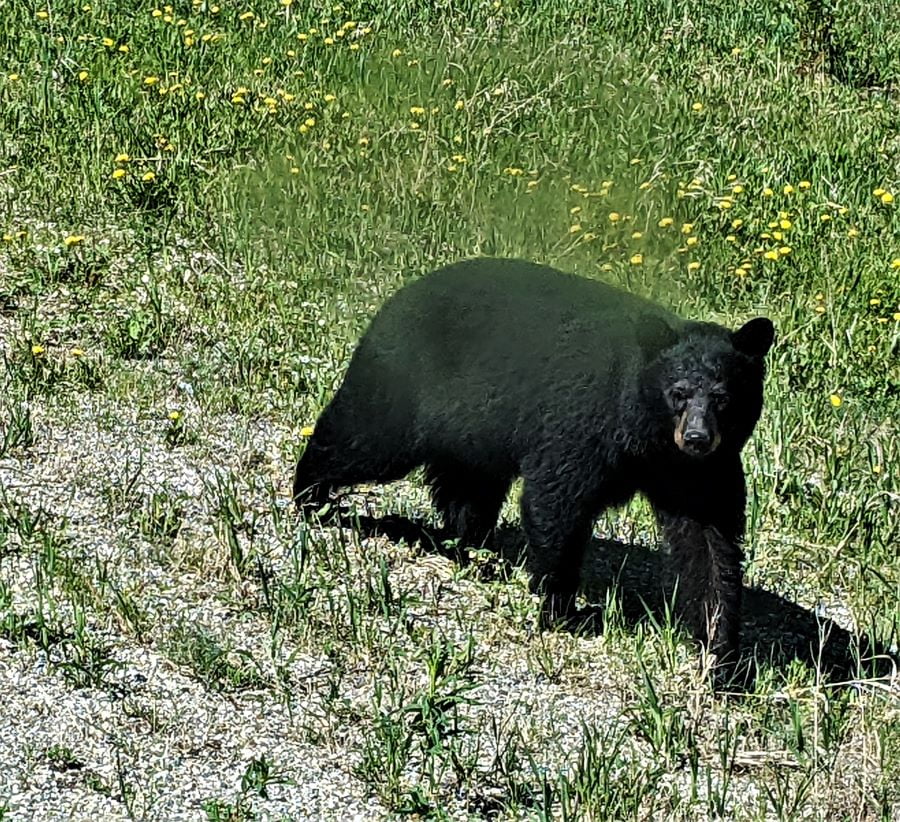
One of the statements that I heard was that if you are watching a Black Bear (who knows about you) and it suddenly runs off you should start looking for a Grizzly Bear.

Grizzly Bears are the very same bear as the Brown Bears, which on Kodiak Island, are known as Kodiak Bears. They used to think that Kodiak Island Brown Bears were an isolated population of giants. That thinking was dispelled when they tracked Brown Bears swimming to and from Kodiak Island which is more than 30 miles across the open ocean.
The same species of Brown Bear is found across the Bering Sea in Russia. As a side note the largest ever bear )of all species including Polar Bears) was a Brown Bear on Kodiak Island. This one weighed about 2500 pounds.
The reason that Brown Bears have two different (or more than two) different names is based on location. Grizzly Bears are found inland (and are smaller) than Brown Bears. The size difference between Brown Bears and Grizzly Bears is based on diet.

Brown Bears eat mostly fish and Grizzly Bears eat mostly grass. Actually, all bears will eat anything. They are not known for sharing. I have mentioned several times that if a bear gets your food, it isn’t your food anymore. Brown Bears have a more protein and fat-rich diet and they get bigger based on the diet. Above all, these large predators are the most dangerous wildlife in Alaska. The moose are included in the group. While moose are not predators, they are dangerous.
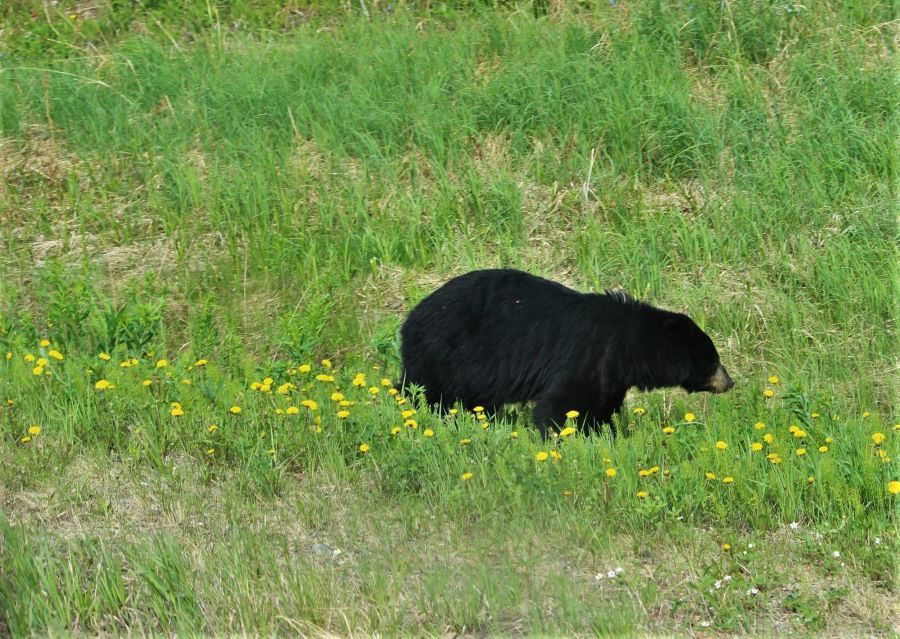
Not all the bears pictured in this post, seen in the lush green grass, are Grizzly Bears. The picture near the top and following this paragraph is a Grizzly sow with three cubs. Since they are inland, far from the ocean, they are Grizzlies. Most of these pictures were taken with a cell phone.
We were inside a Park Service bus and the bears came down the stream bed towards us. It seems that these bears regard the Park Service bus as some kind of mobile rock and are to be ignored as non-food. The pictures of these same three bears were taken while she was eating grass on the hillside with a camera and zoom lens. While mom ate grass, the cubs were waiting for their next chance to nurse and generally playing and exploring.

The bears photographed in the lush green grass were all inside a wildlife rescue area near Portage at the end of the Turnagain Arm of the Cook Inlet. The big Grizzly (Hugo) was found when she was about one year old and had eaten a Porcupine. I can’t explain the (male) name and female gender, but I assure you that the big one was the female. Hugo, besides having porcupine quills still in her paws (making her unable to walk) had been abandoned by her mother.

Mom left her for some unknown reason, perhaps well before the porcupine incident, and without moms teaching, Hugo wouldn’t have survived. Now Hugo has two smaller and younger bears to boss around; one is female and the other a male.

The other bears at the Alaska Wildlife Conservation Center were found along the coastline (thus they are Brown Bears) and were also orphaned after their mother was shot in a homeowner’s backyard. The sow had killed a moose inside the back yard and the homeowner shot it while protecting his property. Then they found the two cubs in a tree and rescued them. One of the two was a male and the other a female. Without the Alaska Wildlife Conservation Center, they too would not have survived.
Wolves (actually only one wolf so far)
While we were staying at K’esugi Ken Campground inside Denali State Park, we took a drive south to the nearest town of Trapper Creek. This is where we saw the wolf crossing the road, well in front of our car, moving at full speed. I am pretty sure it was a wolf, but it may have been a dog/wolf mix. I know it wasn’t a coyote. Wolves are four times the size of coyotes. This one was huge and in a hurry. There are wolves in Denali National Park, but like some of the other residents, we didn’t see any.

Our travels
As I mentioned, and am sure that you know, we are on the loop starting in Tok in the northeastern part of the state on the Alaska Highway. Our first stop in Alaska was in Tok. After Tok, we found the end of the Alaska Highway at Delta Junction. While on a kayak trip on the lake near Tok, we saw our first moose. (or rather, I should say that Tami saw our first moose). Here is a link to that story. Where is the end of the Alaska Highway?

After our stop in Tok, we then went through Delta Junction for a stop in Fairbanks. Fairbanks was our first city in Alaska. Fairbanks is also our first city to see the wildlife inside the city. That is where we saw our second moose. It was about 10 pm and it was along the road moving fast in the opposite direction. Ten pm in June, in Fairbanks, isn’t late (the sun isn’t going to set for a few hours) and we were reminded of that fact over and over again; when even on a good day we weren’t going to see any sunsets (or sunrises). Anyway here is a link to that story. No beautiful sunsets in Fairbanks
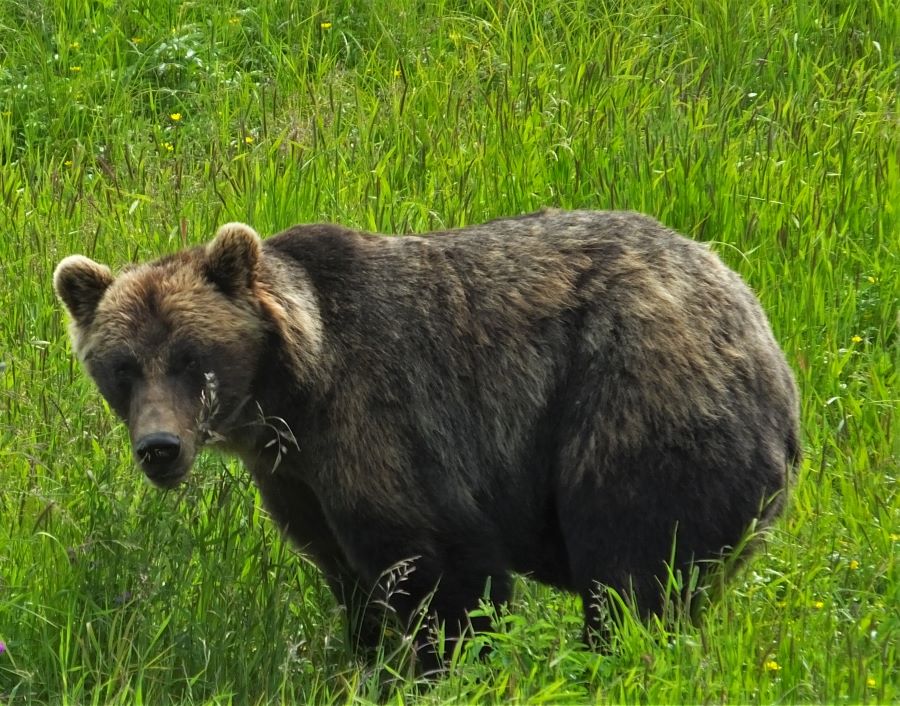
After our move to Denali National Park, we really had lots of chances to see wildlife in Alaska. Denali National Park is about halfway between Anchorage and Fairbanks and is next door to a wilderness that is larger than Texas. To the west of Denali, you will only find towns linked together by rivers and usually only accessed by airplanes. If you really want to see wildlife, that isn’t in a city, then Denali National Park is a great place to see wildlife in Alaska.
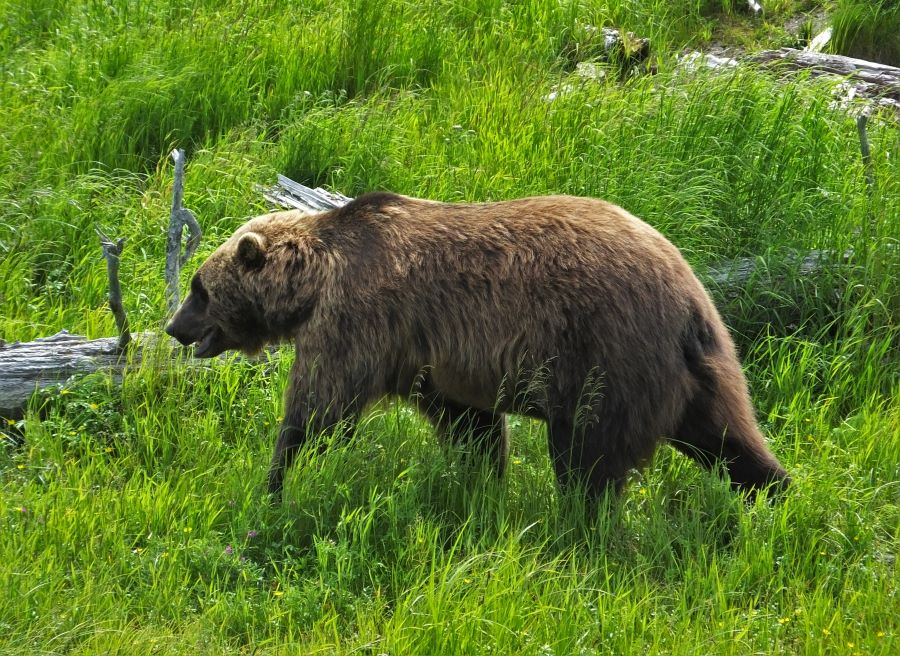
Our primary purpose in Denali was to see the mountain, not the wildlife in Alaska. Here is a link to the story and pictures of seeing the big mountain. Denali is the big mountain in the clouds

The picture above of the Grizzly and cubs and the moose standing in the woods were both at Denali. While at Denali we encountered wildlife in Alaska that we didn’t want to find. These wildlife were very small. I had some severe allergies leading up to and while staying in Denali. Tami however caught (probably) Covid probably while on the bus trip. Or perhaps I brought it with me from Fairbanks and then gave it to Tami while at Denali.

So while staying in Denali we spent our time waiting for the weather to clear, so that we could see the mountain and feeling like crap. Tami couldn’t taste and that is the reason she took a Covid test. The first day it was positive, on the next day the test was negative and she was feeling better.
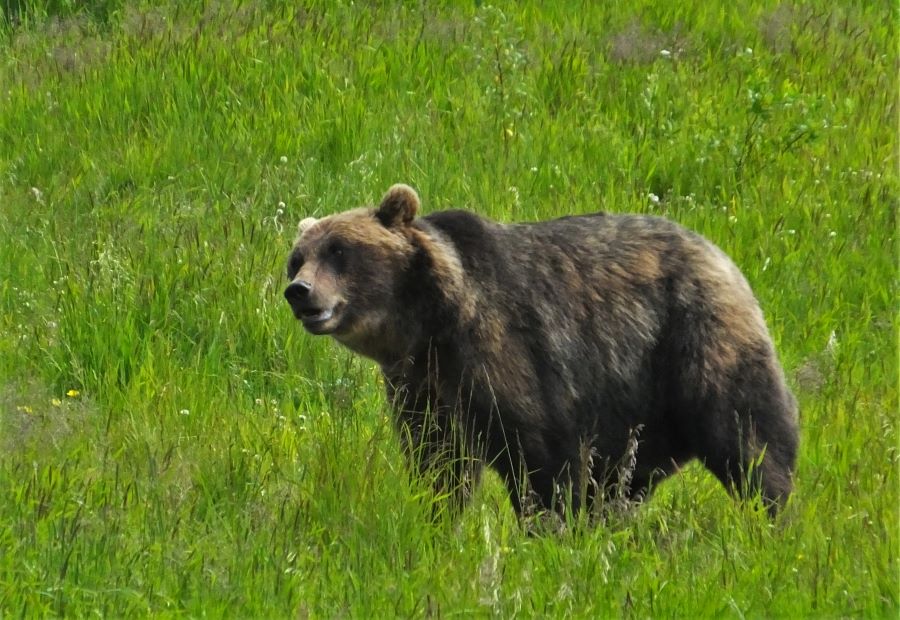
It really isn’t a big bad Covid experience, but it shows us that the virus is still out there giving people problems. As for me, I was feeling better before Tami started feeling bad, so I never took a Covid test. I find it amazing that we were able to avoid Covid for three years and then may have caught it in remote Alaska.
Please subscribe and join us on our journey
We will add you to our email list and send you updates about once a week. Here is a link. Subscribe
About our links
As you know, our blog income is zero – this allows us to be independent and just tell the truth. We do not get income or commissions. No, we don’t make paid endorsements. We don’t make recommendations but instead, we will tell you what we like (or dislike). The links are only provided as a quick reference to help our readers.
Links
Denali National Park Tour Bus Information
Alaska Wildlife Conservation Center
About Comments
We love seeing your comments but they are not automatic. I get about twenty spam comments every day and thus I don’t have automatic comments. I read and then publish every comment personally to protect the blog and keep it on the subject and real. So what this means for you is that you will not see your comment right after you hit submit. Sorry for the delay in publishing your comments. Please know that we love hearing from you.


Thanks for the update with such interesting pictures. Those BEARS of any type are big & beautiful. Glad you recovered from the COVID-19. Stay SAFE, & continue to ENJOY.
Love,
Jersey & Joan
Very interesting. Especially after my bear experience in Larkspur CO last year. I have a lot of respect for these creatures. 🐻
I really enjoy this traditional blog format. I don’t always want to watch a video, and it seems to me that you must enjoy your travels more because all of your attention isn’t on production. We are on year three full timing and still consider ourselves newbies compared to you.
Beautiful pictures Joanne and I will be going to Alaska next year by cruise and to Denali. Stay safe and enjoy! Btw we met Tami on the dock at the end of the boardwalk at Manatee Springs two years ago near Chiefland, Florida and she gave us a business card.
Pingback: Alaska's Playground is the Kenai Peninsula - FoxRVTravel
Pingback: My 100 Best Grizzly Bear Pictures at Katmai National Park - FoxRVTravel